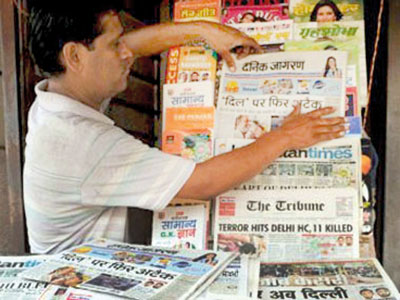Sunday Times 2
Tabloid India
NEW DELHI – When the Bollywood superstar Sridevi Kapoor drowned last month, at age 54, in a bathtub in a Dubai hotel, coverage of her tragic death once again showcased all that is wrong with Indian media. Sridevi – who, after a 15-year hiatus, had made a spectacularly successful return to the silver screen in two mega-hits in the last six years – led a modest and conventional life with her husband, film producer Boney Kapoor, and their teenage daughters. She did not dress or behave in ways that would serve as tabloid fodder or fuel lurid speculation.

Sridevi’s death became the subject of ghoulish stories, particularly on television
Yet Sridevi’s death became the subject of ghoulish stories, particularly on television, about what might have happened behind the closed door of her bathroom, with one TV anchor even attempting to enact a bathtub drowning. A politician notorious for leaping onto every available conspiracy theory went so far as to suggest foul play.
Welcome to India’s extraordinary media environment, in which the fourth estate serves as witness, prosecutor, judge, jury, and executioner. With far too many channels competing 24/7 for the same sets of eyeballs and target rating points (TRPs), television news has long since abandoned any pretence of providing a public service, and instead blatantly privileges sensation over substance. (Indian TV epitomises the old crack about why television is called a medium: because it is neither rare nor well done.)
When it comes to print media, the situation is not much better. Newspapers are now competing in a fast-changing and overcrowded media landscape where it is not they, but TV, that sets the pace: every morning, they must reach readers who have watched TV the previous day. So, instead of providing context, depth, and analysis, newspapers are blasting out headlines that stimulate prurience or outrage.
The result has been disturbing, to put it mildly. The airing of opinions is the cheapest way to fill a broadcast hour; ranting anchors score the highest TRPs. This reinforces the motivation to engage in sensational speculation, however baseless, as has occurred in Sridevi’s case.
More fundamentally, the rush to beat TV by breaking stories has weakened journalists’ incentive to perform due diligence, in terms of researching stories and verifying claims. This erosion of professional standards has too often made newspapers willing accomplices of purveyors of manipulated “leaks” and malicious allegations. The distinctions among fact, opinion, and speculation, between reportage and rumour, and between sourced information and unfounded claims – which are drummed into journalism students’ heads the world over – have faded into irrelevance in today’s Indian media.

India has an extraordinary media environment, in which the fourth estate serves as witness, prosecutor, judge, jury and executioner
The cavalier attitude toward facts is compounded by extreme reluctance to issue corrections. So a blaze of lurid and unverified headlines does untold damage. When corrections are offered, they are too feeble and come too late to restore innocent people’s reputations.
I have experienced the limitations of India’s media firsthand, having been treated to repeated doses of speculation, gossip, accusation, and worse over the course of the last four years, following the tragic death of my wife. Instead of showing the restraint and caution one might expect from a responsible press covering matters of life and death, the media flung around baseless accusations of murder and suicide with abandon.
The media trial of my wife’s death, fuelled by politically motivated leaks, was drawn out as long as possible and made into a spectacle, with voyeuristic TV discussion shows debating accusations and imputations based on zero evidence or even elementary research. Malevolent claims were reported uncritically; editors failed to ask even the most basic questions about their plausibility. And my experience is not unique.
Unsurprisingly, trust in Indian media is eroding. A friend summarised the problem succinctly for me: “When I was young, my father wouldn’t believe anything unless it was printed in the Times of India. Now, he doesn’t believe anything if it is printed in the Times of India.”
This should concern all right-thinking Indians, because free media are the lifeblood of our democracy. The free press is both the mortar that holds in place the bricks of our country’s freedom, and the open window embedded in those bricks.
The news media are supposed to enable a free citizenry to make informed choices about who governs them and how. And, by looking critically at elected officials’ actions (or inaction), they are supposed to ensure that those who govern remain accountable to those who put them there.
Instead, Indian media today report recklessly on ephemera that have no impact on public welfare, and focus constantly on the superficial and the sensational. In doing so, they trivialise public discourse and abdicate their responsibilities as facilitators and protectors of democracy. Far from a call for controls on the free press – no Indian democrat would issue such a call – this is a demand for better journalism.
Government needs a free and professional media to keep it honest and efficient, to serve as both mirror and scalpel. A blunt axe serves no society well. If India wishes to be taken seriously as a responsible global player and a model twenty-first-century democracy, we must take ourselves seriously and behave responsibly.
Our journalism, a face of India that others see and by which – fairly or not – we are judged, would be a good place to start.
(The writer is a former UN under-secretary-general and former Indian Minister of State for External Affairs and Minister of State for Human Resource Development and is currently Chairman of the Parliamentary Standing Committee on External Affairs and an MP for the Indian National Congress.)
Copyright: Project Syndicate, 2018. www.project-syndicate.org

